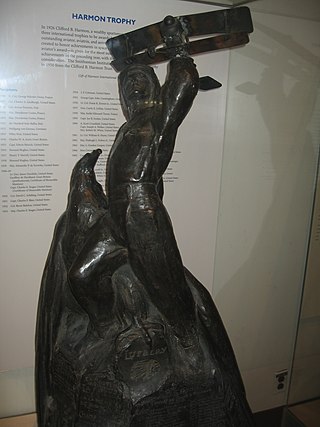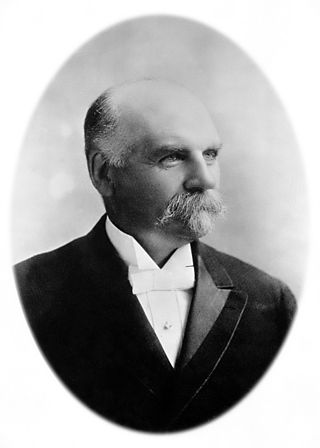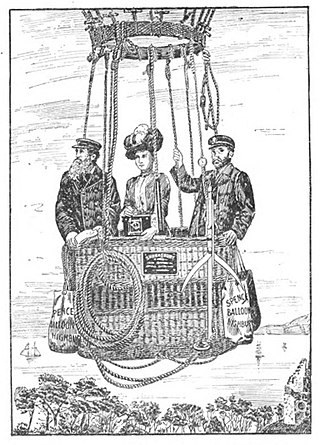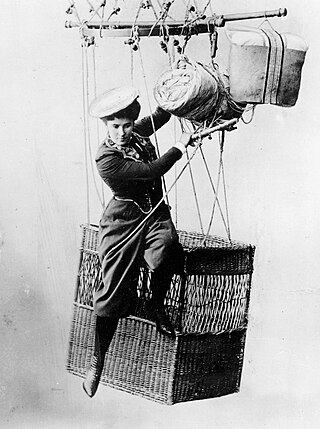
The Harmon Trophy is a set of three international trophies, to be awarded annually to the world's outstanding aviator, aviatrix, and aeronaut. A fourth trophy, the "National Trophy", was awarded from 1926 through 1938 to the most outstanding aviator in each of the twenty-one member countries and again from 1946–1948 to honor Americans who contributed to aviation. The award was established in 1926 by Clifford B. Harmon, a wealthy balloonist and aviator.
This is a list of aviation-related events during the 18th century :
This is a list of aviation-related events during the 19th century :

Thaddeus Sobieski Constantine Lowe, also known as Professor T. S. C. Lowe, was an American Civil War aeronaut, scientist and inventor, mostly self-educated in the fields of chemistry, meteorology, and aeronautics, and the father of military aerial reconnaissance in the United States. By the late 1850s he was well known for his advanced theories in the meteorological sciences as well as his balloon building. Among his aspirations were plans for a transatlantic flight.

Donald Louis Piccard was a Swiss-born American balloon pioneer, promoter, innovator, designer, builder, and pilot.

The Union Army Balloon Corps was a branch of the Union Army during the American Civil War, established by presidential appointee Thaddeus S. C. Lowe. It was organized as a civilian operation, which employed a group of prominent American aeronauts and seven specially built, gas-filled balloons to perform aerial reconnaissance on the Confederate States Army.

Sophie Blanchard, commonly referred to as Madame Blanchard, was a French aeronaut and the wife of ballooning pioneer Jean-Pierre Blanchard. Blanchard was the first woman to work as a professional balloonist, and after her husband's death she continued ballooning, making more than 60 ascents. Known throughout Europe for her ballooning exploits, Blanchard entertained Napoleon Bonaparte, who promoted her to the role of "Aeronaut of the Official Festivals", replacing André-Jacques Garnerin. On the restoration of the monarchy in 1814 she performed for Louis XVIII, who named her "Official Aeronaut of the Restoration".
Élisabeth Thible, or Elizabeth Tible, was the first woman to make a flight in an untethered hot air balloon. She was born in France in Lyon on 8 March 1757. On 4 June 1784, eight months after the first crewed balloon flight, Thible flew with Mr. Fleurant on board a hot air balloon christened La Gustave in honour of King Gustav III of Sweden's visit to Lyon.

The Balloon Farm, originally called the Gates Manshion, is a historic home located at Frankfort in Herkimer County, New York. It includes the Gates-Myers Residence, built in 1878. It is an imposing, nearly square, three-story eclectic Late Victorian dwelling built of dimension lumber above a cut-stone foundation.

Stanley Edward Spencer (1868–1906) was an early English aeronaut, famous for ballooning and parachuting in several countries, and later for building and flying an airship over London in 1902.

Jeanne Geneviève Garnerin was a French balloonist and parachutist. She was the first to ascend solo and the first woman to make a parachute descent, from an altitude of 900 metres (3,000 ft) on 12 October 1799.

Percival Green Spencer was a British pioneering balloonist and parachutist.

Gertrude Bacon was a British aeronautical pioneer. She achieved a considerable number of "firsts" for women in aeronautics, as well as making contributions in the areas of astronomy and botany. Bacon popularised aeronautics through her writing, and promoted both commercial and popular flying as fields for women.
Albert C. Triaca was an Italian balloonist, pioneer aviator, and businessman.

Eugène Godard Ainé was a French aeronaut, born in Clichy on August 26, 1827, died in Brussels on September 9, 1890.

Katharina "Käthe" Paulus was a German exhibition parachute jumper and the inventor of the first collapsible parachute. At the time, 1910, the parachute was named "rescue apparatus for aeronauts". The previous parachutes were not able to fit in a case like apparatus worn on the back, thus Paulus' invention became of paramount importance for the Germans in the First World War and she produced about 7,000 parachutes for the German forces. During the First World War, Paulus created approximately 125 parachutes a week. She was also credited with inventing the "drag 'chute", an intentional breakaway system where one small parachute opens to pull out the main parachute.

Vera Simons (1920–2012) was an inventor, artist, and balloonist. She became known in the 1950s and 1960s as a leader in high altitude gas balloon development and exploration, belonging to a group of pioneers known as the "Pre-Astronauts."

Eleanor Vadala was an American chemist, materials engineer and balloonist. She became director of research and development at the Naval Air Development Center in Pennsylvania, where she helped to develop light synthetic materials for use in aircraft. One of her jobs was the testing of fabric in existing balloons to ensure they could be used safely.

May Constance Assheton Harbord, was the first woman to obtain an Aeronaut's Certificate in the United Kingdom, in 1912.

Carl Edgar Myers (1842–1925) was an American aeronautical engineer. He was born at March 2, 1842 at Herkimer, New York, to Abram H. and Eliza Ann (Cristman) Myers. At various times in his life, he was employed as carpenter, mechanician, plumber, electrician and chemist, banker, and photographer. After 1978, he focused on aeronautical engineering. He became known as the inventor of new or improved systems for generating gases, and as the constructor of hydrogen balloons and airships, including the aerial velocipede, gas kite, sky-cycle and electrical aerial torpedo. He married Mary Breed Hawley on November 8, 1871.


















